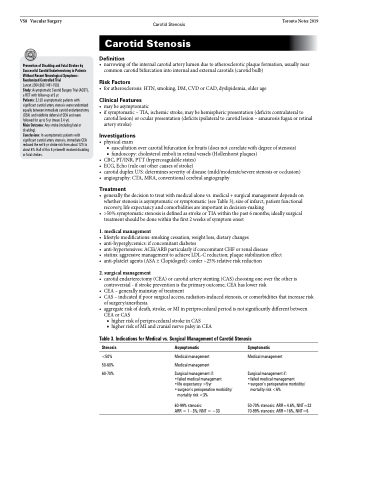Page 1372 - TNFlipTest
P. 1372
VS8 Vascular Surgery
Prevention of Disabling and Fatal Strokes by Successful Carotid Endarterectomy in Patients Without Recent Neurological Symptoms: Randomized Controlled Trial
Lancet 2004;363:1491-1502
Study: Asymptomatic Carotid Surgery Trial (ACST), a RCT with follow-up at 5 yr.
Patients: 3,120 asymptomatic patients with significant carotid artery stenosis were randomized equally between immediate carotid endarterectomy (CEA) and indefinite deferral of CEA and were followed for up to 5 yr (mean 3.4 yr).
Main Outcome: Any stroke (including fatal or disabling).
Conclusions: In asymptomatic patients with significant carotid artery stenosis, immediate CEA reduced the net 5-yr stroke risk from about 12% to about 6%. Half of this 5 yr benefit involved disabling or fatal strokes.
Carotid Stenosis Toronto Notes 2019 Carotid Stenosis
Definition
• narrowingoftheinternalcarotidarterylumenduetoatheroscleroticplaqueformation,usuallynear common carotid bifurcation into internal and external carotids (carotid bulb)
Risk Factors
• foratherosclerosis:HTN,smoking,DM,CVDorCAD,dyslipidemia,olderage
Clinical Features
• maybeasymptomatic
• ifsymptomatic–TIA,ischemicstroke;maybehemisphericpresentation(deficitscontralateralto
carotid lesion) or ocular presentation (deficits ipsilateral to carotid lesion – amaurosis fugax or retinal artery stroke)
Investigations
• physicalexam
■ auscultation over carotid bifurcation for bruits (does not correlate with degree of stenosis) ■ fundoscopy: cholesterol emboli in retinal vessels (Hollenhorst plaques)
• CBC,PT/INR,PTT(hypercoagulablestates)
• ECG,Echo(ruleoutothercausesofstroke)
• carotidduplexU/S:determinesseverityofdisease(mild/moderate/severestenosisorocclusion) • angiography:CTA,MRA,conventionalcerebralangiography
Treatment
• generallythedecisiontotreatwithmedicalalonevs.medical+surgicalmanagementdependson whether stenosis is asymptomatic or symptomatic (see Table 3); size of infarct, patient functional recovery, life expectancy and comorbidities are important in decision-making
• >50%symptomaticstenosisisdefinedasstrokeorTIAwithinthepast6months;ideallysurgical treatment should be done within the first 2 weeks of symptom onset
1. medical management
• lifestylemodifications:smokingcessation,weightloss,dietarychanges
• anti-hyperglycemics:ifconcomitantdiabetes
• anti-hypertensives:ACEi/ARBparticularlyifconcomitantCHForrenaldisease
• statins:aggressivemanagementtoachieveLDL-Creduction;plaquestabilizationeffect • anti-plateletagents(ASA±Clopidogrel):confer~25%relativeriskreduction
2. surgical management
• carotidendarterectomy(CEA)orcarotidarterystenting(CAS)choosingoneovertheotheris controversial - if stroke prevention is the primary outcome, CEA has lower risk
• CEA–generallymainstayoftreatment
• CAS–indicatedifpoorsurgicalaccess,radiation-inducedstenosis,orcomorbiditiesthatincreaserisk
of surgery/anesthesia
• aggregateriskofdeath,stroke,orMIinperiproceduralperiodisnotsignificantlydifferentbetween
CEA or CAS
■ higher risk of periprocedural stroke in CAS
■ higher risk of MI and cranial nerve palsy in CEA
Table 3. Indications for Medical vs. Surgical Management of Carotid Stenosis
Stenosis Asymptomatic
<50% Medical management 50-60% Medical management 60-70% Surgical management if:
•failed medical management
•life expectancy >5yr
•surgeon’s perioperative morbidity/
mortality risk <3%
60-99% stenosis:
ARR = 1 - 3%; NNT = ~33
Symptomatic
Medical management
Surgical management if:
•failed medical management •surgeon’s perioperative morbidity/
mortality risk <6%
50-70% stenosis: ARR=4.6%, NNT=22 70-99% stenosis: ARR=16%, NNT=6


